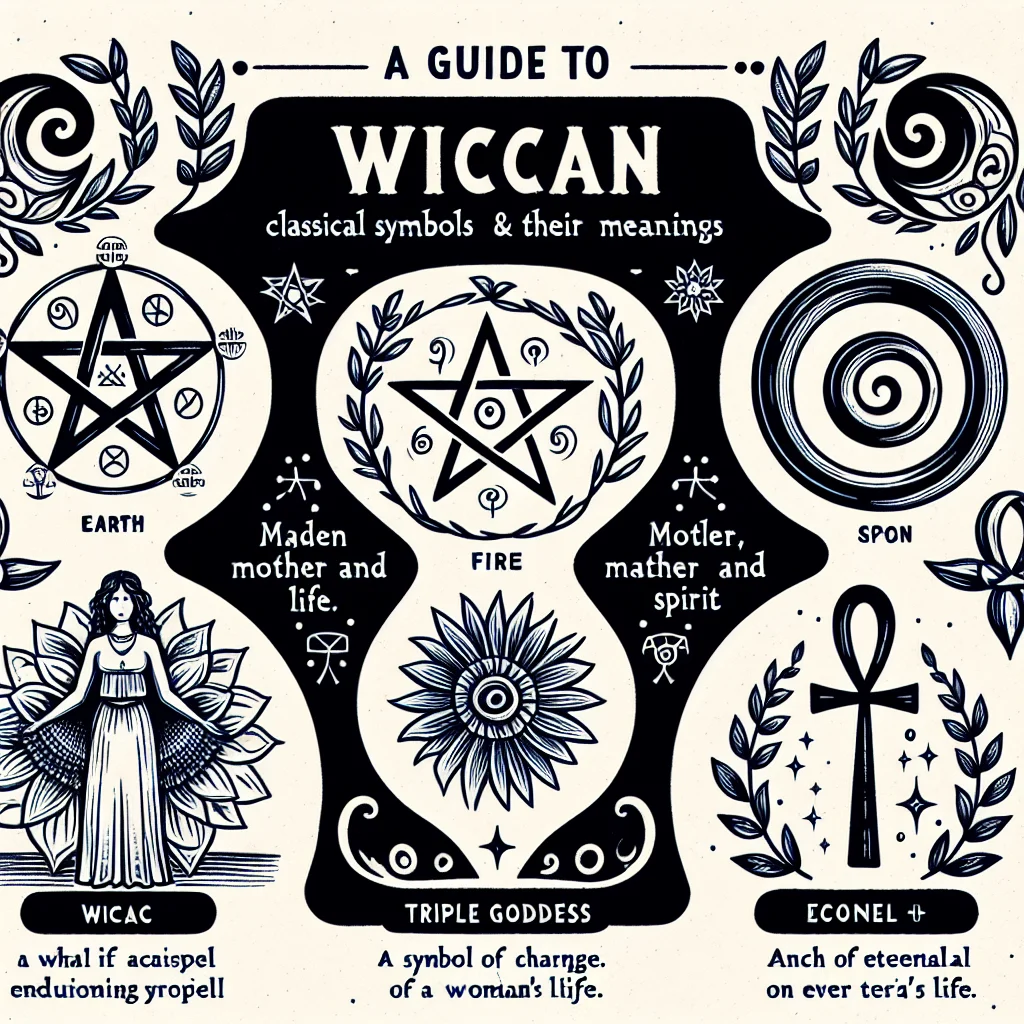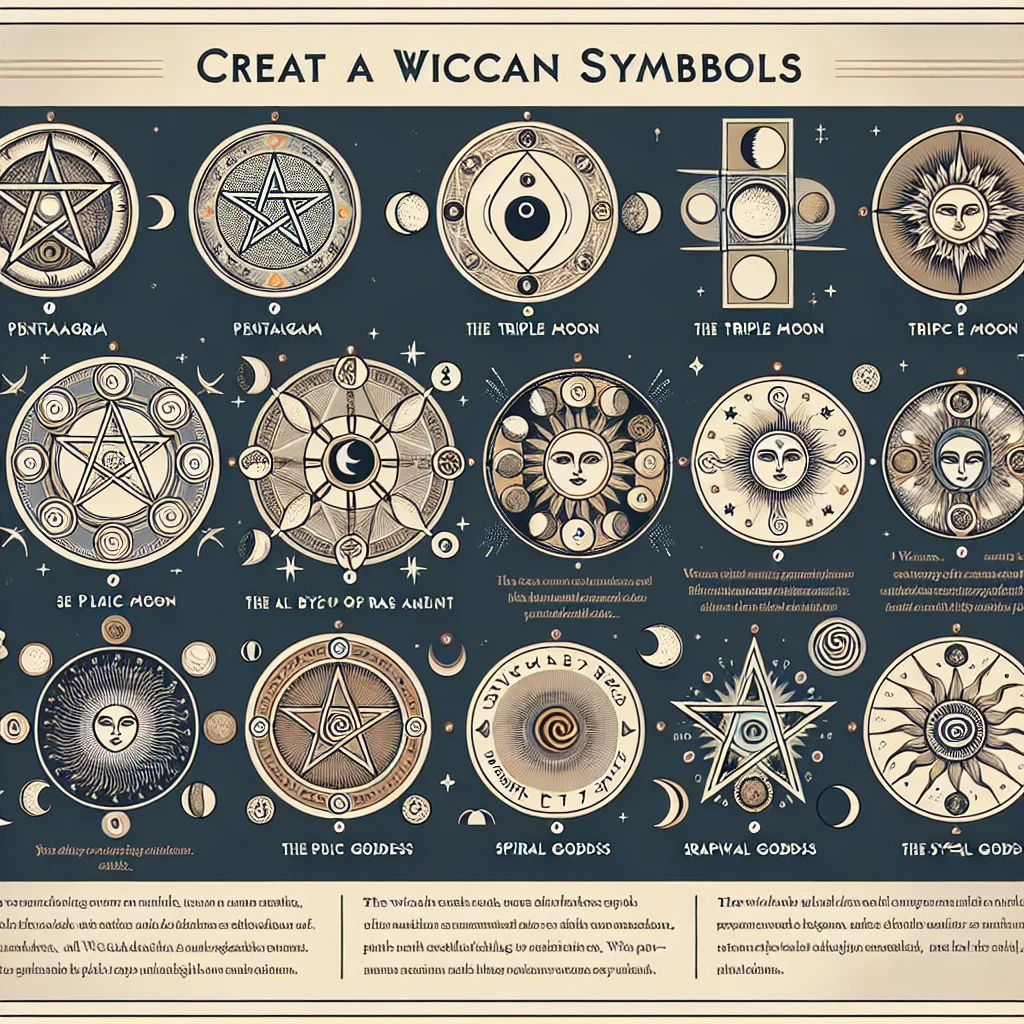As an Amazon Associate I earn from qualifying purchases.
↻
Last updated: December 24, 2025

Wicca, a modern pagan religion that emerged in the mid-20th century, is rich with unique symbols derived from various historical, spiritual, and magical sources. These symbols serve as focal points for meditation, magical work, and as representations of deeper spiritual truths. Many of these symbols are intertwined with the belief in the interconnectedness of all things and serve as tools to express and understand the complexities of their faith.
The pentagram, a five-pointed star inscribed within a circle, is among the most recognizable symbols in the Wiccan tradition. Each point of the star represents an element: earth, air, fire, water, and the fifth point symbolizes spirit, overlaying and connecting the physical elements as a reminder of the unity between the physical world and the spiritual realm. This symbol is often worn by practitioners as a pendant, embodying protection and the balance of forces.
Another significant emblem is the Triple Moon, symbolizing the three phases of the moon—waxing, full, and waning—correlated to the Triple Goddess, an important deity in Wicca that represents the Maiden, Mother, and Crone aspects of the female experience. This symbol mirrors the Wiccan belief in the cyclical nature of all existence and the idea of rebirth and renewal.
An engaging piece of trivia is that the spiral, a simple yet potent symbol found in Wiccan tradition, is among the oldest geometric shapes found throughout the ancient world. It represents the life-force, growth, and the perpetual cycles of change seen in the seasons, the life cycle, and the constant motion of the cosmos. In Wicca, spirals can represent the journey from outer consciousness to the inner soul and the expansion of the mind and spirit.
The use of these symbols extends beyond personal practice. For instance, during sabbats, which are seasonal festivals marking the Wheel of the Year, various symbols are incorporated into ceremonies and rituals to symbolize the particular energies or deities being honored at that time. This not only enriches the observance of the sacred days but also serves to align the participants with the natural rhythms of the Earth.
Given the resurgence of interest in nature-centric spiritual paths, Wicca's symbols are resonating with an increasingly diverse and growing population, evidenced by the fact that Wicca is considered one of the fastest-growing religions in the United States. Its symbols offer a deep well of meaning to those who seek to understand and work with them, contributing to their growing popularity and integration in various aspects of modern spirituality.
`
What Are the Meanings Behind Wiccan Symbols?
`
Wiccan symbols are rich in significance, each carrying unique energy and profound meanings that resonate deeply with practitioners of Wicca and paganism. These symbols act as tools for ritual practices, talismans for protection, and visual representations of core principles of the Wiccan belief system. They encapsulate important aspects of the natural world, the elements, and the interconnectedness of all life. Understanding the meanings behind Wiccan symbols can provide insight into the beliefs and traditions of Wicca as well as offer guidance and focus during personal growth and spiritual practice. Dive deeper into the mystical world of Wiccan symbolism in the following sections, where we explore the ancient origins, the elemental associations, and the practical applications of these powerful and enchanting icons.
Wiccan symbols and their meanings are an intricate and fundamental part of the practice of Wicca, a modern Pagan religion with spiritual roots in the earliest expressions of reverence for nature. Among these symbols, there are a few that stand out for their wide recognition and deep symbolic significance within the tradition.
**Pentagram**
One of the most quintessential Wiccan symbols is the pentagram, a five-pointed star encased within a circle, known as a pentacle when circumscribed. Each point of the star represents an element: earth, air, fire, water, and the topmost point symbolizes spirit. The enclosing circle is often interpreted as symbolizing unity and protection. This emblem is used in various rituals and magical work to call forth energy and to represent the interconnectedness of all elements and the divine.
**Triple Moon**
The Triple Moon symbol, depicting the waxing, full, and waning phases of the moon, signifies the goddess in her three forms: the Maiden, the Mother, and the Crone. These forms represent the lifecycle of a woman, the phases of the moon, and also the stages of growth in nature. This symbol is particularly connected to feminine energy, intuition, and psychic insight.
**Triquetra**
The Triquetra or the Trinity Knot is comprised of three interlocked arcs. It symbolizes the threefold nature of existence – mind, body, and spirit, or the triple goddesses as mentioned before. In some interpretations, it also stands for the concept of eternity and the interconnectedness of all life, with the unbroken lines reflecting an uninterrupted cycle of life, death, and rebirth.
**Spiral**
The Spiral is a symbol that radiates out from a center point, representing the journey from external consciousness to the inner soul and vice versa. In Wiccan tradition, it symbolizes growth, expansion, and cosmic energy. It also represents the goddess and fertility, reflecting the natural shape of the curled fetus before birth.
**Ankh**
Though it originally comes from Egyptian symbolism, the Ankh has been adopted into Wiccan practice. It represents life, the flow of divine energy, and the balance between opposing forces. Its looped top is often seen as representing eternal life, while the cross reflects the material plane.
**Wheel of the Year**
The Wheel of the Year is not just one symbol but a complex calendar representing the eight Wiccan Sabbats which are seasonal festivals marking the turning of the seasons and cycles of life, death, and rebirth. The wheel itself is symbolic of time's cyclical nature and the ongoing progression of life.
**Athame**
While not a symbol in the visual sense like the others, the athame, or ritual dagger, is symbolic in its use within Wiccan practice. It's associated with the element of fire and is used to direct energy, draw magical boundaries, or “cut” ethereal ties. The athame represents will and the ability to differentiate between the material and ethereal realms.
Wiccan symbols and their meanings are deeply embedded in their rituals and beliefs, as these emblems serve as physical representations of the faith's core tenets and concepts. They are used as tools of meditation, aids in magic, and as a means for Wiccans to express their spirituality.
In terms of statistics, it's challenging to determine the exact number of people who identify with and practice Wicca, due to its decentralized nature and the personal, often solitary practice of many adherents. However, a Pew Research Center report on religious and spiritual experiences in the United States (from a study conducted in 2014) estimated that approximately 0.4% of Americans (roughly 1.5 million as of the time of the study) identify with New Age religions, which may include Wicca. Worldwide, numbers are harder to pinpoint, but it's clear Wicca has a global presence.
https://youtube.com/watch?v=A-4NT–pU3E
- What are Wiccan symbols?
Wiccan symbols are visual representations that hold significance within the Wiccan religion, encompassing various concepts such as elements of nature, deities, spiritual principles, and magical workings. These symbols are often used in rituals, magical practice, and as amulets for protection.
- Can non-Wiccans use Wiccan symbols?
While non-Wiccans can appreciate or use Wiccan symbols, it is important to understand and respect their meanings and origins. Using these symbols without knowledge or reverence for their significance may be considered disrespectful by some practitioners.
- What is the meaning behind the Pentacle or Pentagram in Wicca?
The pentacle or pentagram is a five-pointed star enclosed in a circle. Each point represents an element: earth, air, fire, water, and spirit. It symbolizes protection, the unity of these elements, and the connection between the material world and the divine.
- Is the Pentagram always used as a symbol of evil?
No, the pentagram is not inherently evil. In Wicca, it is a positive symbol of protection and balance. However, it has been mistakenly associated with evil, largely due to its inverted form being adopted by certain satanic groups, which is a separate and distinct usage from that of Wicca.
- What does the Triple Moon symbol represent in Wicca?
The Triple Moon symbol represents the three phases of the moon—waxing, full, and waning—associated with the aspects of the Goddess as the Maiden, Mother, and Crone. It symbolizes the cycle of life and the divine feminine.
- How are the four classical elements represented in Wiccan symbols?
In Wicca, the four classical elements—earth, air, fire, water—are often represented by symbols such as the pentacle (with each point symbolizing an element), specific colors, ceremonial tools, and elemental triangles. They are integral to many Wiccan rituals and practices.
- What is the significance of the Triquetra in Wiccan belief?
The triquetra, or triple knot, is a symbol with three interconnected loops with no beginning or end. Wiccans may interpret its significance as representing interconnectivity and the threefold concept such as life, death, rebirth or the three aspects of the Goddess.
- Are Wiccan symbols used similarly to Sigils, and can they be personalized?
Wiccan symbols are sometimes used like sigils, as talismans or to manifest intentions. While traditional symbols have specific meanings, Wiccans may also create their own personalized symbols or sigils for specific magical purposes or to symbolize personal beliefs.
- What role do Wiccan symbols play in rituals and ceremonies?
Wiccan symbols play a central role in rituals and ceremonies acting as focal points for channeling energy, invoking deities, delineating sacred space, and representing the intentions of the practitioner. They are often inscribed on altars, tools, and ritual objects.
- How can one respectfully learn more about Wiccan symbols?
One can respectfully learn about Wiccan symbols by studying reputable sources on Wicca, such as books by established Wiccan authors, accessing educational resources from credible organizations, attending workshops, or connecting with practicing Wiccans willing to share their knowledge.

Conclusion
The exploration of Wiccan symbols has revealed a rich tapestry of meanings and insights integral to the practice and belief system of Wicca. From the quintessential Pentacle, representing the five elements and offering protection, to the spiral of the Triple Goddess symbolizing the divine feminine in her three aspects, these symbols act as focal points for worship, reflection, and ritual. The understanding of each symbol, such as the Horned God representing masculine energy, and the Witch's Knot signifying magical influence and the binding of power, unfolds the layered complexity of Wiccan spirituality, underscoring the religion's deep connection with nature, the divine, and the cyclicity of life and the seasons.
Moreover, the use of these symbols extends beyond mere representation; they are integral components of Wicca's magical framework. Each mark carries with it a specific energy and intention, whether it is for protection, love, health, or abundance, and is used in casting spells, creating talismans, or marking sacred space. The study of Wiccan symbols also provides insights into the ethical and moral values underpinning the Wiccan Rede, as many of these icons embody the principle of “An it harm none, do what ye will.” In turn, these symbols serve not only as instruments of magical practice but also as ethical guideposts, reflecting the Wiccan commitment to living in harmony with the world.
Amazon and the Amazon logo are trademarks of Amazon.com, Inc, or its affiliates.
Continue Your Magical Journey
Free Witchcraft Starter Kit
Get 6 free printable PDFs: grimoire pages, moon calendar, spells, crystals, herbs, and tarot journal.
We respect your privacy. Unsubscribe anytime.
Enhance Your Practice
As an Amazon Associate, I earn from qualifying purchases.

